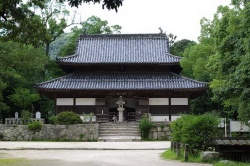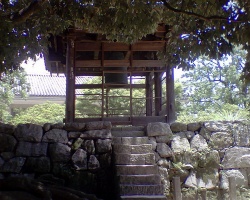Kanzeon-ji
Kanzeon-ji
観世音寺 Kanzeon-ji
A temple of the Tendai school located in Chikuzen Province in Japan. Though Emperor Tenchi (626-671) ordered its construction, it was not completed until 746, well after his death. In 761 an ordination hall was added, making it one of the three ordination centers in Japan, the other two being at Todai-ji in Nara and Yakushi-ji in Shimotsuke Province. In 1064 the temple was destroyed by fire but was later rebuilt. Today, however, only the main hall and the Amida hall remain.
Kanzeon-ji (観世音寺?) is a seventh-century Buddhist temple in Dazaifu, Fukuoka, Fukuoka Prefecture, Japan. It was once the most important temple in Kyushu. Its bell, one of the oldest in the country, has been designated a National Treasure, and in 1996 the Ministry of the Environment designated its sound as one of the 100 Soundscapes of Japan. Many statues of the Heian period are Important Cultural Properties.
History
According to the Shoku Nihongi, Kanzeon-ji was founded by Emperor Tenji in honour of his mother Empress Saimei, but was still incomplete fifty years later when in 709 additional workers were assigned to finish the building. The temple had a south gate, middle gate, golden hall to the west, pagoda to the east and a lecture hall in the centre. The temple's buildings were damaged and destroyed in a number of natural disasters and wars. The Kondō, 3x2 bays with mokoshi, and lecture hall were rebuilt in the Genroku era (1688-1703) and have been designated Prefectural Cultural Properties. The grounds and ruins of Kanzeon-ji (観世音寺境内及び子院跡?) were declared an Historic Site in 1970.
Treasures
Kanzeon-ji houses a National Treasure and a number of statues and other items that are Important Cultural Properties:
bell (梵鐘?) of the Nara period (National Treasure)
wooden seated statue of Amida Nyorai)] (木造阿弥陀如来坐像?) of the Heian period
wooden statue of Amida Nyorai (木造阿弥陀如来立像?) of the Heian period
wooden seated statue of Kannon (木造観音菩薩坐像?) of the Heian period (1066)
wooden statue of Kannon (木造観音菩薩立像?) of the Heian period
wooden statue of Kannon (木造観音菩薩立像?) of the Heian period
wooden statue of Kichijōten (木造吉祥天立像?) of the Heian period
set of wooden statues of the Shitennō (木造四天王立像?) of the Heian period
wooden statue of Jūichimen Kannon (木造十一面観音立像?) of the Heian period
wooden statue of Jūichimen Kannon (木造十一面観音立像?) of the Heian period (1069)
wooden statue of Jūichimen Kannon (木造十一面観音立像?) of the Kamakura period (1242)
wooden statue of Daikoku-ten (木造大黒天立像?) of the Heian period
wooden statue of Jizō (木造地蔵菩薩半跏像?) of the Heian period
wooden statue of Jizō (木造地蔵菩薩立像?) of the Heian period
wooden statue of Batō Kannon (木造馬頭観音立像?) of the Heian period
wooden statue of Bishamonten (木造毘沙門天立像?) of the Heian period
wooden statue of Fukūkenjaku Kannon (木造不空羂索観音立像?) of the Kamakura period (1222)
three wooden bugaku masks (木造舞楽面?) of the Kamakura period
stone komainu (石造狛犬?) of the Kamakura period
bronze mirror (銅製天蓋光心?) of the Nara period
A Heian period inventory of Kanzeon-ji (観世音寺資財帳?) dating to 905 and now in Tokyo has been designated a National Treasure.

